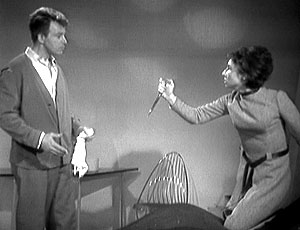
The Daleks saw the Doctor and the Tardis crew make their first trip together to an alien world and in doing so encountered their first alien beings who would prove to be the most iconic in the series’ history. The impact of the Daleks was immediate and saw the show’s viewing figures climb dramatically, establishing it in the public consciousness. As a creation they transcend the programme and it is remarkable to think that they represented just the kind of ‘bug-eyed monster’ that the series’ creators had initially set out to avoid.
Following on from An Unearthly Child, the initial exchanges in The Daleks are a slight disappointment. The dialogue between the show regulars that had sparked with tension in the first story here falls a little flat. Terry Nation the writer of the serial and creator of the Daleks has a reputation for writing good adventure stories, but his dialogue is often less impressive. The actors also seem to be having a tricky time delivering the lines, with their excellent naturalistic performances from the first serial slightly slipping in quality in the early stages of the new adventure. William Hartnell fluffs the odd line, but I should point out at this stage that these mistakes have never bothered me. There’s an argument from some fans that many of the so-called fluffs were deliberate on the part of Hartnell as part of his characterisation of the Doctor. Personally I think the fluffs are understandable mistakes given the pressure on the actor and the ridiculously tough recording schedule he and the acting team had to deal with. There are times when they interrupt the flow, but more often than not they make little difference and deliberate or not can be seen as part of the charm of the first Doctor.
The Daleks had two different directors over it’s seven episode run, Christopher Barry and Richard Martin. Both make some interesting choices and there are some very nice touches such as when Barbara places her hand on the camera lens when feeling her way around a wall. Generally though the more interesting and experimental elements of the direction jar with what is a pretty static piece. In particular the directors seemed to struggle with exactly how to make the scenes involving just the Daleks seem interesting given their lack of movement and often long speeches. That said, Barry does provide us with one of the most iconic shots in Doctor Who history as episode one ends with Barbara pressed against the wall in fear as we see a Dalek arm approaching her.
So to our eponymous monsters. They make their first full appearance in episode two and the first thing that is noticeable about them is how incredibly verbose they are. The nature of the Dalek speech pattern and their relatively static nature in this serial does cause a few issues with the flow and rhythm of the adventure, nonetheless their initial appearance makes an immediate impact. It’s well worth stating in the week of his sad death that this is in no small part down to the brilliant work of Raymond Cusick. The design of the monsters has barely changed in fifty years and the many subsequent attempts to recreate their success by later designers demonstrates just how impressive Cusick’s achievements were. It is also notable that at this early stage the Daleks haven’t quite developed their exterminate on sight policy. They initially simply temporarily paralyse Ian when he attempts to escape and overall these Daleks are far more scheming and thoughtful than many of their later incarnations. In episode four we get our first tiny glimpse of the insides of a Dalek. I mentioned in my review of An Unearthly Child how particularly in the early stages of the show much use was made out of the reactions of the actors to events happening off screen. This is a classic example of how well that can work to cover up a limited budget and the limits of special effects. When Ian and the Doctor lift up the lid of the Dalek casing their reaction is immediately one of horror and disgust, it’s a wonderful moment and it allows the audience to imagine what they may have seen. Shortly after we get a glimpse under a Thal cloak of the Dalek and though it is only fleeting it can’t really live up to the effect of that initial reaction shot.
By the end of the serial there are the first signs of the Doctor who we see as a hero starting to show themselves. However, at the beginning he is still very much the untrustworthy and seemingly selfish individual we left at the end of An Unearthly Child. As the Tardis crew land on the unfamiliar planet they all agree that they should leave as soon as possible and only the Doctor wants to stay. He therefore lies to his companions, claiming that he needs mercury for the Tardis fluid link in order to leave, ultimately endangering the lives of them all just to satisfy his scientific curiosity. His first thought remains his own safety and he is seemingly quite happy to leave Barbara stranded when it first becomes clear they are in danger, even snapping at Susan when she challenges him for this reaction. Despite this there is evidence of a bond developing between him and Barbara later in the story. First he praises her ingenuity when they overpower the Dalek and then later they form an alliance when attempting to persuade Ian to use the Thals to get into the Dalek city. Ian’s relationship with the Doctor remains frostier, but they enjoy a nice moment after the Doctor gets Ian’s name wrong. The Doctor remains happy to leave the Thals to deal with the Daleks on their own until he realises they cannot leave without first returning to the Dalek city. It’s noticeable though that at the end of the adventure the Doctor remains with the Thals for longer than is absolutely necessary, suggesting that his meeting with the pure evil of the Daleks, coupled with his introduction to Ian and Barbara has already made him re-assess his general policy of non-intervention and self-preservation.
As the Thals are introduced the story turns into an attack against pacifism as Ian and the crew attempt to persuade their alien allies that fighting the Daleks is essential if they are to survive. Sadly the Thals come across as being rather bland. It’s ironic that given the clear influence of the Nazis on the Daleks that the Thals are positively arian in their looks and while they look mostly the same they are also fairly indistinguishable as characters. The exception is the character of Antodus, who though mostly whiny and cowardly, does have his own personality and when eventually dying in a moment of self-sacrifice he completes an interesting character arc that is sadly lacking with his fellow Thals. Of course the Tardis crew do eventually manage to persuade the Thals of the need to fight and the Doctor’s response of “the mind will always triumph” to Ian’s query of how they were supposed to take on the Daleks with no weapons can be seen as a defining mantra for the show in the ensuing years.
The link between the Daleks and the Nazis is often mentioned and it’s clear from very early on in their creation, most blatantly in episode six when their arms point upwards in a Nazi style salute and they chant of becoming ‘the master race’. Ian had earlier pinpointed the Daleks hatred of the Thals as simply a ‘fear of the unlike’ though there is again a slight irony in the positioning of this statement. It comes in the middle of a scene in which Barbara and Ian talk regularly of a lack of humanity and human characteristics in the Daleks and the tone and manner of their speech makes it clear that they are including the Thals under the umbrella of the term ‘human’ simply because they look like them, when of course they are really just as alien as the Daleks.
Ultimately The Daleks isn’t the best Dalek serial in Doctor Who, but as the first it is an early watershed moment in the history of the show. The Daleks themselves are very successful and they provide a genuine menace that makes it easy to understand why they caught on to such an enormous extent. The Doctor and his companions’ relationships are continuing to develop alongside the series itself. A development that would kick on once more with the next serial, the unique The Edge of Destruction.



















